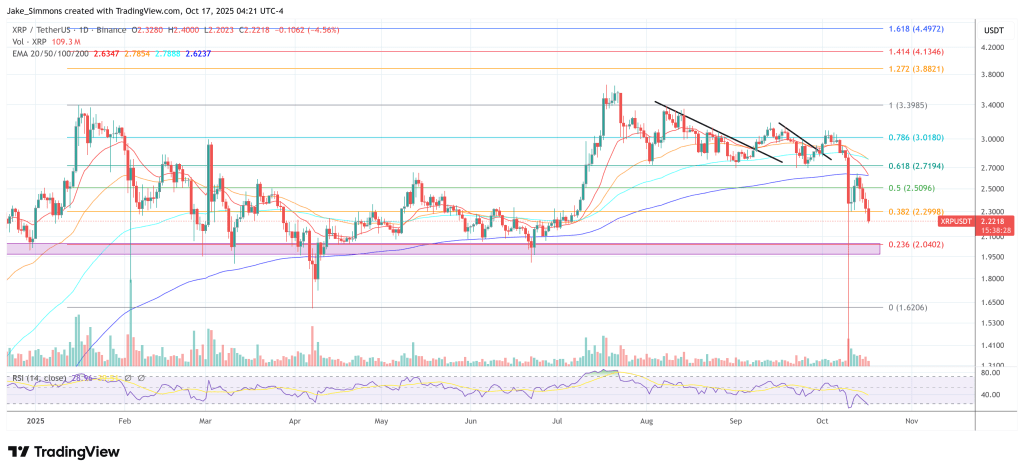Ripple’s settlement to amass GTreasury has triggered a pointy, technically knowledgeable response on X, the place a number of long-time market observers argue the deal quietly routes XRP and Ripple’s stablecoin ambitions into the middle of company finance. Their case rests on the place GTreasury sits within the worth chain, what it already connects to, and the way Ripple can insert settlement decisions—XRP or RLUSD—with out forcing enterprises to alter screens, ERPs, or financial institution relationships.
Why The GTreasury Deal Is Huge For Ripple And XRP
“I’m fairly positive nobody in crypto Twitter even understands what that is,” wrote developer Vincent Van Code (@vincent_vancode), earlier than laying out why the plumbing issues. “GTreasury gives software program that allows primarily giant, multinational companies [to] deal with funds, liquidity, money stream and many others. The software program hyperlinks into banking and fee programs akin to SWIFT, and is ISO20022 compliant.”
In different phrases, GTreasury will not be a speculative guess on future rails; it’s an orchestration layer that already standardizes and routes money, messages, and danger knowledge between a company’s financial institution portals, fee networks, and ERP.
Van Code’s key implication is distribution, not hype: “So this acquisition together with Hidden Roads and Normal Custody and Belief, permits Ripple to introduce digital property into the $100T Treasury market. Ripple doesn’t must ‘promote’ XRP to the massive corporates, that’s simply a part of the plumbing. The SaaS and UI doesn’t change, it simply means Ripple progressively rolls out sooner, extra environment friendly rails. That’s the sport.”
That line of considering is echoed by Ray Fuentes (@RayFuentesIO), who argues the strategic shortcut will not be merely technical but in addition authorized and compliance-oriented. “As soon as this deal clears with GTreasury, Ripple will personal a treasury platform already reside within the SWIFT-interoperability lane. Translation: no constructing SWIFT integrations from scratch—there’s a authorized, technical, and compliant path in place. HUGE win for enterprise adoption. #XRP.”
The purpose is much less a few headline-grabbing re-architecture and extra a few low-friction insertion into flows that already go audit, safety, and regulatory muster. If the financial institution and ERP adapters are in place, new settlement choices might be uncovered as toggles relatively than rebuilds.
What Ripple Will get From The Acquisition
Wrathof Kahneman (@WKahneman) expands the distribution map and the product floor space by situating GTreasury in its historic and technical context. “They’ve ~40 years integrating w/ 800+ banks worldwide. They combine instantly with main ERP programs like SAP, Oracle, & NetSuite, and connects to main banks like JPMorgan, Goldman Sachs, Financial institution of America, Wells Fargo, and PNC.”
That record issues as a result of company treasurers don’t purchase ledgers or tokens; they purchase time-tested connectivity that received’t break money positioning, FX hedging, pooling, and reconciliation. The argument is that after Ripple owns the connectivity material and the consumer interface, it may floor settlement paths—on-ledger through XRP, on-chain through RLUSD, or established order—behind an unchanged workflow.
That is additionally why @WKahneman frames the deal as “Direct entry to the company world cash motion. With this Ripple can convey #RLUSD & #XRP settlement choices into current treasury workflows. A co might transfer funds throughout subsidiaries, currencies, or counterparties immediately, w/ altering software program or banks. It’s the final mile for company finance.”
The operative phrase is “current treasury workflows.” Treasurers stay inside SAP, Oracle, or NetSuite, whereas GTreasury orchestrates financial institution messages and funds. If Ripple can slot XRPL or RLUSD as routable choices below that orchestration, the adoption barrier turns into a coverage choice, not a programs undertaking.
The Lengthy-Time period Plan
The buying sample that led right here will not be incidental. @WKahneman tallies the stack: “Metaco – $250 million (2023) / Hidden Street – $1.25 billion / Rail – $200 million / GTreasury – $1 billion. Ripple has spent ~$3b constructing an entire company finance stack. They’ll provide each layer between a company CFO’s dashboard and on-chain settlement.”
Framed this manner, Metaco covers custody and tokenization controls; Hidden Street provides institutional execution and collateral plumbing throughout venues; Rail provides stablecoin fee orchestration; GTreasury turns into the company command console with financial institution and ERP integrations.
This in flip raises the query most readers leap to: how, precisely, does this contact XRP? @WKahneman doesn’t over-promise however attracts the strategic circle: “I do know, I do know,… ‘however what about XRP?’ I’ll go away it to you to contemplate what the implications are for an organization that was constructed across the XRPL changing into embedded in company finance whereas holding 40% of the XRP provide. It’s essential market penetration.”
The assertion will not be that XRP turns into necessary; it’s that XRP turns into native—current on the level of choice inside treasury workflows the place velocity, pre-funding, and FX paths are calculated. If the “bridge asset” case is ever to be examined at scale, it won’t be through retail hypothesis however through the quiet default settings of treasury middleware.
At press time, XRP traded at $2.22.

Featured picture created with DALL.E, chart from TradingView.com

Editorial Course of for bitcoinist is centered on delivering totally researched, correct, and unbiased content material. We uphold strict sourcing requirements, and every web page undergoes diligent assessment by our crew of prime expertise consultants and seasoned editors. This course of ensures the integrity, relevance, and worth of our content material for our readers.








